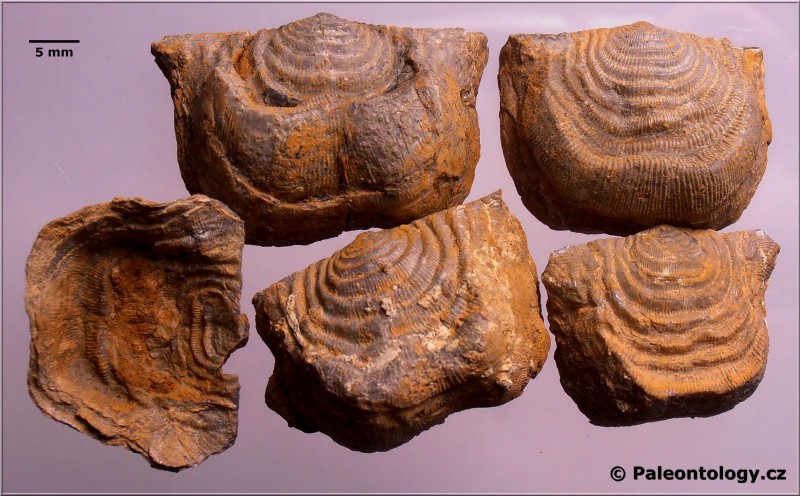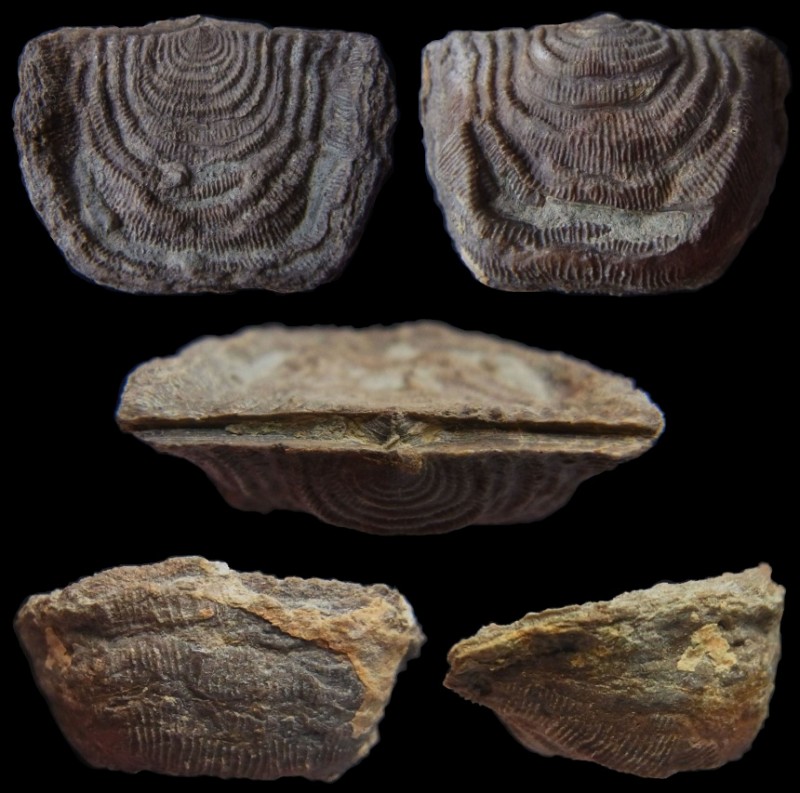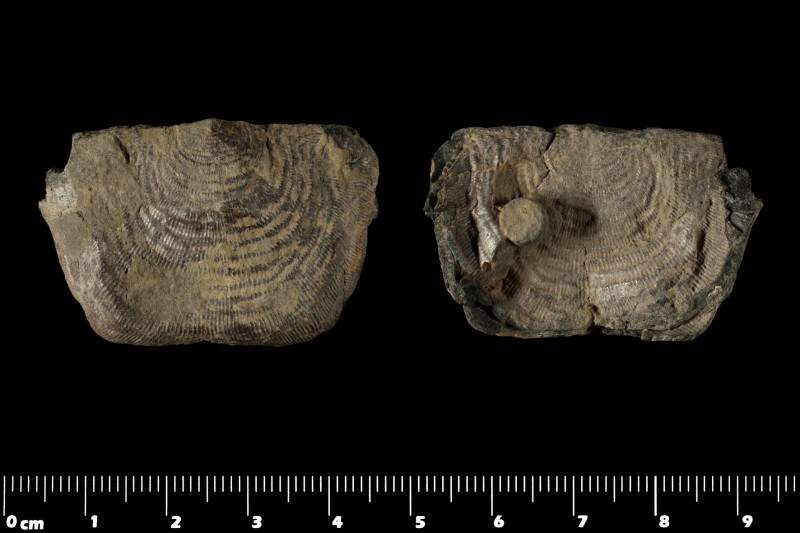PALEO 2022:06
Fossil taxa:
Leptagonia analogaeformis (Biernat, 1966) Halamski et Balinski, 2013
Martin Pavela *
* Czech Paleontological Society, Na pastvisku 10, Opava, 74705, ČR
Key words: Brachiopoda, Strophomenida, Leptagonia, Devonian, Eifelian

Fig.1: Leptagonia analoageformis (Biernat, 1966) Halamski et Balinski, 2013 - Czech Paleontological Society (PPC)
Holy Cross Moutains / Grzegorzowice Formation / Skaly Member / Grzegorzowice - Skaly; Devonian / Eifelian
- Position in a system (Zařazení v systému):
Phyllum: Brachiopoda
Subphyllum: Rhynchonelliformea
Class: Strophomenata
Order: Strophomenida
Family: Rafinesquinidae
Subfamily: Leptaeinae
Genus: Leptagonia
Species: Leptagonia analogaeformis
- Synonyms (Synonyma):
Leptaena analogaeformis - Biertnat 1966
- Description (Popis): (Biernat 1966) Medium sized shell of subquadrate outline , with hinge extremities auriculate, to varying degree geniculate; rugate disc as long as trail, sometimes shorter, trail of variable length, straight anteriorly or slightly undulated. Pedicle valve: pedicle foramen small, circular lying a short distance from apex.
Ornamentation. Radial costellae fine, regularly spaced, 3-5 per 1 mm.; concentric rugae thick , usually contiguous, sometimes a little wavy, 8-13 in number, in general reflected on the internal surface of younger individuals. Shell pseudopunctate. Interior. Pedicle valve: teeth strong; muscle area rhomboidal in outline, bordered partly by strongly divergent dental plates and very high, sharp lateral ridges, converging anteriorly; adductors small, divided by a septal ridge of varying length; diductors larger, often flabellate, sometimes radially striated; two parallel , very delicated ridges, probably intervascular in front of the muscles (see PI. Ill, fig. 11). Brachial valve: cardinal process stout with divergent lobes, of varying appearance, often asymmetrical (see Text-fig. 6); chilidium large, medially grooved; dental sockets deep, each bordered by two ridges, the internal could be interpreted as a weak brachiophore (according to HAVLICEK, 1963, p. 223, one of the most diagnostic characters for Leptaena); median septal ridge of variable thickness, usually low, highest at the anterior end of the muscle area; muscles well impressed, but without distinct lateral ridges; on the trail pallial sinuses observed (PI. Ill, fig. 14).
Growth changes. Not much can be said about growth changes in this species, as a range of specimens representing the full growth stages is lacking. The collection contains only a few immature separate pedicle and brachial valves about 3·5 mm. in length and completely adult specimens. Small shells of young individuals, found in two clusters in the shales of exposure 121, range from about 2 mm. to about 3·5 mm. in length. They are more wide than long, having a comparatively large, round pedicle foramen, hinge line smaller than the maximum shell width; concentric rugae occupy much more than half the whole valve length, all subcircularly outlined except the first, which is subquadrate and placed apically. The radial striae, 17 in number, start about 1·2 mm. from both apexes, hence, specimens slightly smaller than 1·2 mm. long are smooth, with only concentric rugae (PI. IV, figs. 8,9). With growth, the number of concentric rugae and radial striae progressively increases; specimens about 6·3 mm. long and 7·2 mm. wide possess about 5 concentric rugae and 40 radial striae, while those 7·2 mm. long and 8·8 mm. wide have 9-10 rugae and about 50 radial striae. The external sculpture is reflected in the interior. The trail (geniculation) is a feature of adult growth stage , lacking in young individuals.
In the brachial valve interior there is a median septal ridge , extending from the base of the cardinal process to the anterior margin of the valve. In some pedicle valves a corresponding median furrow is observed, projecting anteriorly from midlength of valve. Crural plates are slightly elevated; small but distinct dental sockets observed. In general, the studied growth stages of this species show a great regularity in the development of the internal structure and considerable stability in its appearance.
Variability within the species. The collection of Leptaenas, coming from a few exposures within the Skaly beds, is mostly small , sometimes represented by single shells. They are in different state of preservation, some being very incomplete (e.g. shells from exposures 121, 125). This greatly limites the possibilities for detailed studies of growth changes and individual variability.
In the collection are: 1) usually complete thick-walled gerontic individuals and separate valves (exposures 72 and 73); 2) casts of separate valves of youthful individuals (exposure 121); 3) thin-walled and, as a rule , crushed and deformed shells of mature individuals from exposure 125; 4) thick-walled mature specimens embedded in the limestone coming from Miloszow. All specimens are referred to one species - Leptaena analogaeformis n. sp. The small differences which occur do not merit diagnostic value , even of subspecific rank, being due to environment, as local conditions can slightly modify some features of external and internal morphology of the same species. Differences in our material are expressed in the shell size and outline and to some extent in the appearance and number of concentric rugae. The specimens from limestone, although adult, are the smallest in the collection, being nearly quadrate in outline with the greatest shell width at the hinge line, hinge extremities well auriculate (e. g. PI. IV, figs. 1-4). Shells in argillaceous and marly shales are much larger and subquadrate in outline. The dimensions of visceral disc are nearly the same in all specimens, but its relation to the trail is different (see Text-fig. 7). Some variability may also be observed in the appearance of the chilidium (Text-fig. 6) and chilidial groove, and internally in the appearance of the cardinal process lobes with myophores, sometimes more marked, sometimes less (Text-fig. 6). The ventral muscle area of different specimens is unstable especially in outline and slightly in dimensions (Text-fig. 7).
- Stratigraphic range (Stratigrafické rozšíření): Devonian / Eifeliann
- Geographic range (Geografické rozšíření): Poland, Germany, Morocco
Holy Cross Moutains: Grzegorzowice Formation / Skaly Member
PPC: Grzegorzowice - Skaly
- Photos of a typical specimens (Fotografie typických exemplářů):

Fig.2: Leptagonia analoageformis (Biernat, 1966) Halamski et Balinski, 2013 - HOLOTYPE - Balinski 1966
Holy Cross Moutains / Grzegorzowice Formation / Skaly Member / Grzegorzowice - Skaly; Devonian / Eifelian
- Schematic drawings (Schematické nákresy):


Fig.3-4: Leptagonia analoageformis (Biernat, 1966) Halamski et Balinski, 2013 - Balinski 1966
- Material (Materiál): Czech Paleontological Society (PPC): 200+ pcs
- Remarks (Poznámky):
- Additional illustration (Doplňkové ilustrace):

Fig.5: Leptagonia analoageformis (Biernat, 1966) Halamski et Balinski, 2013 - Nils Jung - steinkern.de
Germany / Eifel / Hillesheimer Mulde; Devonian / Eifelian

Fig.6: Leptagonia analoageformis (Biernat, 1966) Halamski et Balinski, 2013 - mnhn.fr
Morocco / Maider; Devonian / Eifelian

Fig.7: Leptagonia analoageformis (Biernat, 1966) Halamski et Balinski, 2013 - Halamski, Balinski et Koppka 2022
Morocco / Nothern Maider; Devonian / Eifelian
- References (Reference):
Biernat G., 1966. Middle Devonian Brachiopods of the Bodzentyn Syncline (Holy cross Moutains, Poland). - Paleontologia Polonica, 17: 1-162.
Halamski, A.T., Baliński, A. & Koppka, J., 2022. Middle Devonian brachiopods from northern Maïder (eastern Anti-Atlas, Morocco). Annales Societatis Geologorum Poloniae, 92: 1–86.
- Quote this article (Citace tohoto příspěvku):
Pavela M. (2022): Fossil taxa: Leptagonia analogaeformis (Biernat, 1966) Halamski et Balinski, 2013. PALEO 2022:06
- Date of publishing (Datum publikování): 3.4.2022
- Photogallery (Fotogalerie):
© All right reserved / Všechna práva vyhrazena. Žádnou část webu, fotografii, část textu, jeho skladbu, slovní spojení atd. nelze bez původního písemného souhlasu nebo jasně formulované, zde uváděné citace vyjímat či napodobovat a používat!